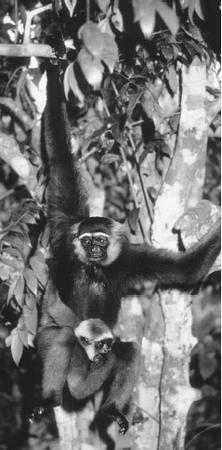|
This section contains 377 words (approx. 2 pages at 300 words per page) |
Gibbons (genus Hylobates, meaning "dweller in the trees") are the smallest members of the ape family which also includes gorillas, chimpanzees, and orangutans. They spend most of their lives at the tops of trees in the jungle, eating leaves and fruit. They are extremely agile, swinging at speeds of 35 mph (56 km/h) with their long arms on branches to move from tree to tree. The trees can even be 50 ft (15 m) apart. They have no tails and are often seen walking upright on tree branches. Gibbons are known for their loud calls and songs, which they use to announce their territory and warn away others. They are devoted parents, raising usually one or two offspring at a time and showing extraordinary affection in caring for them. Conservationists and animal protectionists who have worked with gibbons describe them as extremely intelligent, sensitive, and affectionate.
Gibbons have long been hunted for food, for medical research, and for sale as pets and zoo specimens. A common method of collecting them is to shoot the mother and capture the nursing or clinging infant, if it is still alive. The mortality rate in collecting and transporting gibbons to areas where they can be sold is extremely high. This, coupled with the fact that their jungle habitat is being destroyed at a rate of 32 acres (13 ha) per minute, has resulted in severe depletion of their numbers.
 A gibbon. (©Breck P. Kent/JLM Visuals. Reproduced by permission.)
A gibbon. (©Breck P. Kent/JLM Visuals. Reproduced by permission.)
Gibbons are found in southeast Asia, China, and India, and nine species are recognized. All nine species are considered endangered by the U.S. Department of the Interior and are listed in the most endangered category of the Convention on International Trade in Endangered Species of Wild Fauna and Flora (CITES). IUCN—The World Conservation Union considers three species of gibbon to be endangered and two species to be vulnerable. Despite the ban on international trade in gibbons conferred by listing in Appendix I of CITES, illegal trade in gibbons, particularly babies, continues on a wide scale in markets throughout Asia.
Resources
Books
Benirschke, K. Primates: The Road to Self-sustaining Populations. New York: Springer-Verlag, 1986.
Preuschoft, H., et al. The Lesser Apes: Evolutionary and Behavioral Biology. Edinburgh: Edinburgh University Press, 1984.
Other
International Center for Gibbon Studies. [cited May 2002].
|
This section contains 377 words (approx. 2 pages at 300 words per page) |


